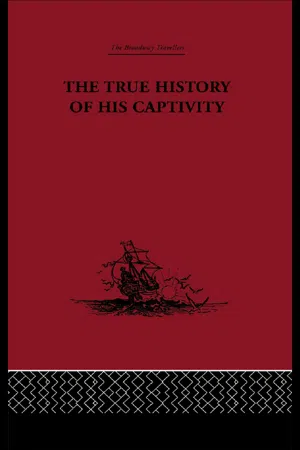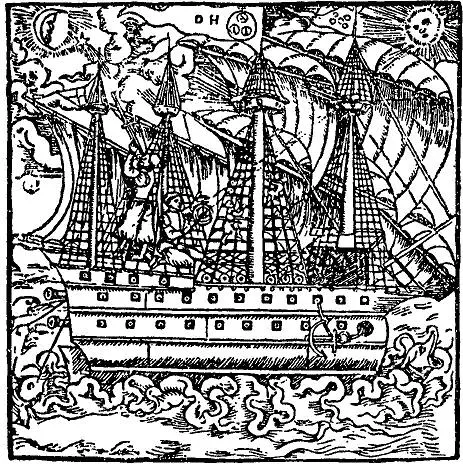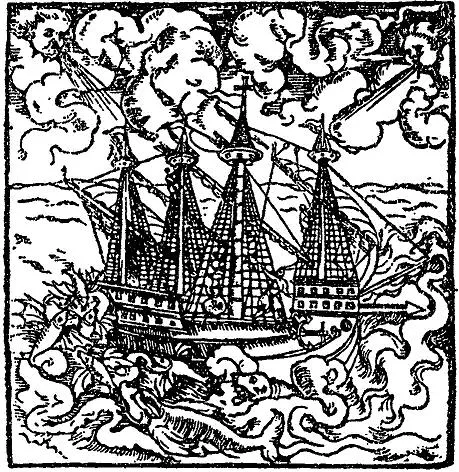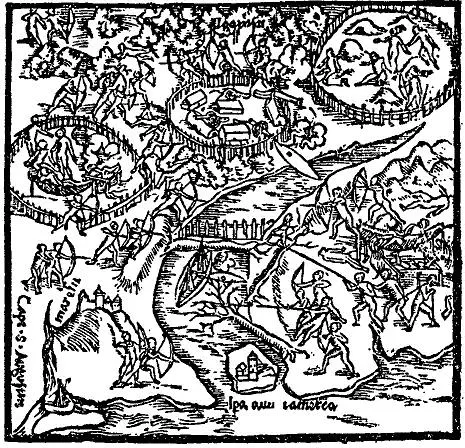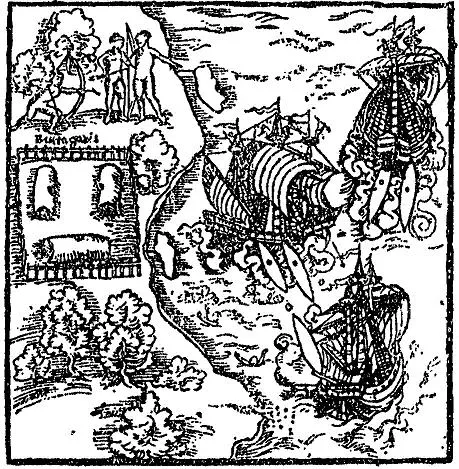![]()
PART ONE
The watcher in the town,
The mighty ships upon the ocean :
If the Lord keep them not their labour is vain.
![]()
CHAPTER I
[The voyage to Portugal.]
I HANS STADEN of Homberg in Hesse proposed, if God willed, to see the Indies, and with this intention I travelled from Bremen to Holland, where at Kampen I lighted upon a boat which was sailing for Portugal to take in salt. I embarked accordingly, and on the 29th day of April of the year 1547 we arrived at a town called Sanct Tuval (Setubal), the voyage having taken four weeks. Thence I reached Lisbon which is distant from St. Tuval (Setubal) five miles.8 At Lisbon I lodged at an inn owned by a man known as the younger Leuhr, a German, with whom I stayed some time.9 I spoke with the host, my countryman, and told him that if it were possible I desired to see the Indies. He informed me that I had delayed too long, since the King’s ships bound for the Indies had departed. I asked him therefore, since he knew the language, to help me to find another ship, and told him that if he could do so I should be much in his debt.
Thereupon he took me to a boat where I obtained employment as a gunner. The captain’s name was Pintiado, and he was bound for Brazil on a trading voyage, but he had leave to attack certain ships which were trafficking off the coast of Barbary with the White Moors, and to seize as prizes any French ships which he might find in Brazil trading with the savages.10 He carried with him also certain prisoners who had been convicted and sentenced to death, but who had been spared with the object of colonizing the New World.11
Our ship was well found and fitted with every kind of warlike contrivance which could be used at sea. There were three Germans on board, Hans von Bruchhausen, Heinrich Brant of Bremen and I.
![]()
CHAPTER II
My first voyage from Lisbon in Portugal.
WE sailed from Lisbon, having with us another small boat also commanded by our captain, and arrived first at the Island of Madeira which belongs to the King of Portugal and is inhabited by the Portuguese. It is fruitful in wine and sugar. In this island, at a place called Funtschal, we victualled our ship.
Thence we sailed towards Barbary, to a town called Cape de Gel,12 which belongs to a king of the White Moors named Schiriffe. This town belonged formerly to the King of Portugal, but this Schiriffe took it from him again. We had expected to find here the ships I have mentioned above, which were trafficking with the infidel.
When we arrived and were close to the shore we came upon numbers of Castilian fishermen who informed us that there were certain ships in the neighbourhood of the town, and as we sailed on there came out of the harbour a vessel which was very well laden. This ship we attacked and captured, but the crew escaped in the boat. We then espied an empty boat lying on the shore which would serve us well for boarding the prize, and we accordingly landed in order to take it. Thereupon the White Moors came down in force, intending to defend it, but they could not withstand our shots. We then returned to Madeira with our prize, which was laden with sugar, almonds, dates, goat-skins and gum-arabic, and dispatched the small boat back to Lisbon for orders as to how we were to proceed, since the cargo was the property of Valentian and Castilian merchants.
The orders received were to leave the cargo in the island and continue our voyage, the King intimating that he would inform himself in the meantime concerning the whole matter. We thereupon returned to Cape de Gel seeking for further prizes. But our labour was in vain, for a land wind arose which hindered us.
On All Hallows Eve, driving before a great storm, we sailed from Barbary for Brazil, and when we were about 400 miles from the coast of Barbary great shoals of fish surrounded the ship which we caught with lines and hooks. Some of these, which the sailors called albakore,13 were large, others, called bonitte, were smaller, and others were called durado. There were also fish about as large as herrings which had wings on either side like a bat, and these were closely pursued by the larger fish. When chased they lifted themselves out of the sea, vast numbers or them, and flew some two fathoms high above the water, and others quite close to it, for as far as we could see. Then they dropped again into the water. We often found them in the morning lying on the deck, having fallen into the ship at night during their flight. They are called in the Portuguese tongue pisce bolador. Then continuing on our voyage we sailed under the equinoctial line where we encountered great heat, for the sun stood still above our heads as if it were perpetual noon. For days there was no wind, and at nights came great thunderstorms with rain and wind which departed as quickly as they came, so that continual watch had to be kept lest they should catch us unawares while we were under sail.
The wind now blew with great force for several days against us until we began to be afraid that if it continued we should die of hunger, and we cried to God for a favouring wind. Then it came to pass one night, when we were in the midst of a great storm and sorely troubled, that blue lights began to appear in the ship such as I had never seen before. Where the waves struck the bows, there the lights appeared. The Portuguese said that the lights were a sign of good weather and were sent by God to comfort us. And as we praised God the lights vanished. These lights are called Santelmo,14 or Corpus Santon. When day broke the weather improved, a light wind sprang up, and we knew that these lights were indeed a sign from God.
So sailing onwards, on the 28th day of January, we sighted a spit of land called Cape de Sanct Augustin.15 Eight miles farther on we reached the harbour of Prannenbucke (Pernambuco), having been eighty-four days at sea without sighting land. In this place the Portuguese had a settlement called Marin.16 The commander was named Artokoslio,17 to whom we delivered our prisoners and some of our cargo, intending to sail away and take in fresh cargo elsewhere.
![]()
CHAPTER III
How the savages of the place called Prannenbucke (Pernambuco) rebelled and strove to expel the Portuguese from their settlement.
IT so happened that the savages who inhabit this place rebelled against the Portuguese who had enslaved them, and the commander besought us for the love of God to occupy a settlement called Garasu,18 five miles from the harbour of Marin where we lay, which had been attacked by the savages. The people at Marin were powerless to help the settlers, for they feared an attack from the savages.
Accordingly we set off to Garasu with forty men from our ship, travelling there in a small boat. The settlement lay in an arm of the sea which extended two miles inland. The defenders numbered some ninety Christians under arms. To them might be added thirty Moors and Brazilian slaves, the property of the settlers. The attackers were estimated to number about 8,000; we were closely invested and had only a palisade of rails to protect us.
![]()
CHAPTER IV
The nature of our defences and how they fought against us.
THE settlement in which we were besieged was surrounded by woods in which the savages had made two forts out of trees, and thither they retreated at night or when we attacked them. In addition they had dug pits in the ground, and here they lay hid during the day ready to attack us, and when we fired at them they dropped into the pits and so escaped our shots. Indeed, they had invested us so closely that we could not stir. They approached the settlement and fired arrows into the air, intending that they should fall upon us behind our defences. They used also arrows bound with cotton and wax which they lit, hoping to set fire to the roofs of our huts, boasting that they would eat us when they caught us. We on our part had very little to eat, and what we had was soon finished, for it was the custom to fetch daily or every other day fresh roots to make meal or cake, and now we could not stir to get them.
When we saw that we were becoming short of food we sent two boats to a place called Tammaraka19 for provisions, but the savages had thrown great trees across the channel and had assembled on either shore to prevent us. We were able to break through these obstructions, but about half way we ran aground. The savages could not reach us, but they threw down dry wood from their camp between the boats and the shore, intending to set fire to it and to burn the pepper which grows there, and thus to smoke us out or the boats. They did not succeed, however, and in the meantime the tide returned and we reached Tammaraka in safety and replenished our stores. We then set out on our return voyage, but once again the savages sought to stop us. They had thrown trees into the channel as previously, and were waiting in the shelter of the shore. They had also partly felled two trees and had tied them at the top with a plant called Sippo, which grows like a hop plant but is thicker. They made fast the ends in their camp, intending as we passed to pull the ropes so that the trees might fall and crush our boats.
The first tree, as we broke through, fell towards their camp, the second fell behind us in the water, and as we passed through we called to our companions in the settlement to come to our assistance. Then the savages set up a great shout so that the men in the settlement should not hear us, for there was a thick wood between us and the camp, and our companions could not see us although we were close to them and they could have heard us if the savages had not raised their shouts.
At last, however, we reached the settlement with the victuals, and when the savages saw that they could do nothing they made overtures for peace and with drew. The siege had endured almost for a month. Several of the savages were dead, but we had not lost a man.
When we saw that the savages desired peace we returned to our ship at Marin and took in water and mandioca meal, and the commander was much indebted to us for what we had done.
![]()
CHAPTER V
How we sailed away from Prannenbucke (Pernambuco) to a country called Buttugaris and engaged a French vessel.
WE now sailed for forty miles to the harbour of Buttugaris,20 where we intended to ship a cargo of Brazilian wood and to raid the natives for food.
Here we fell in with a French ship which was loading wood, and we engaged it intending to capture it, but our mainmast was shot away and the ship escaped. Several of our men were killed or wounded.
We then determined to set out once more for Portugal, for the winds were contrary and we could not make the harbour where we intended to re-victual the ship. So we sailed homewards, short of victuals, suffering such hardship from lack of food that some devoured the goatskins which were on board. Each day there was served out to us a ration of water and a little meal made from Brazilian roots. We were 108 days at sea, and on August 12 we arrived at the Azores, belonging to the King of Portugal, where we anchored, rested and fished. Here we fell in with a ship which we hailed enquiring what it was. It turned out to be a pirate, and prepared to attack us, but we captured it, although the crew escaped among the islands in the boats. The ship contained a rich cargo of wine and bread which greatly refreshed us. After this we fell in with five ships belonging to the King of Portugal which were awaiting the fleet from the Indies to escort it home. We remained there and escorted an Indiaman to the Island of Tercerca (Terceira), where we remained. Here we found assembled a great company of vessels which had all come from the New World, some bound for Spain and some for Portugal, and when we left Terceira we were almost a hundred strong. We arrived at Lisbon about October 8, 1548, and our voyage had lasted sixteen months.
At Lisbon I rested for a time, but was consumed with the wish to see the new lands occupied by the Spaniards. I therefore left Lisbon in an English ship bound for Castile and landed in Porta Santa Maria where the captain wished to take in a cargo of wine. Thence I reached Seville where I found three ships being refitted which were bound for Rio de Plata in America. This country, with the gold district of Peru, which was discovered some years ago, forms with Brazil one continent.
Several ships were sent some years ago to conquer this country, but some returned for further assistance with the news that it was passing rich in gold. The commander of these three ships was Don Diego de Senabria,21 who was to become the King’s governor in the country. I attached myself to one of these ships, all of which were well found, and sailed from Seville to San Lucar, where the river from Seville enters the sea, and here we lay waiting for a favourable wind.
![]()
CHAPTER VI
My next voyage from Seville in Spain to America.
ON the 4th day after Easter22 in the year of our Lord 1549 we set sail from San Lucar, but the wind was contrary and we entered the harbour at Lisbon. Then, when the wind improved, we sailed for the Canary Islands and anchored close to an island called Pallama (Palma) where we took in wine for the voyage. And the navigators agreed that if the ships were separated at sea they would make for land in twenty-eight degrees south of the equinoctial line.
From Palma we sailed to Cape Verde, that is the Green Headland, which lies in the country of the Black Moors, where we narrowly escaped shipwreck. The wind was contrary and carried us to the coast of Guinea which is likewise inhabited by the Black Moors, whence we reached the island of S.Thomé which belongs to the King of Portugal. This island is rich in sugar, but unhealthy. The Portuguese live there with numbers of Black Moors who are their slaves. Here we took in fresh water and sailed on, but in a storm during the night we lost touch with the two ships which accompanied us, and we therefore sailed on alone. The wind was still contrary, for it happens in these seas, where the sun is north of the equinoctia...
